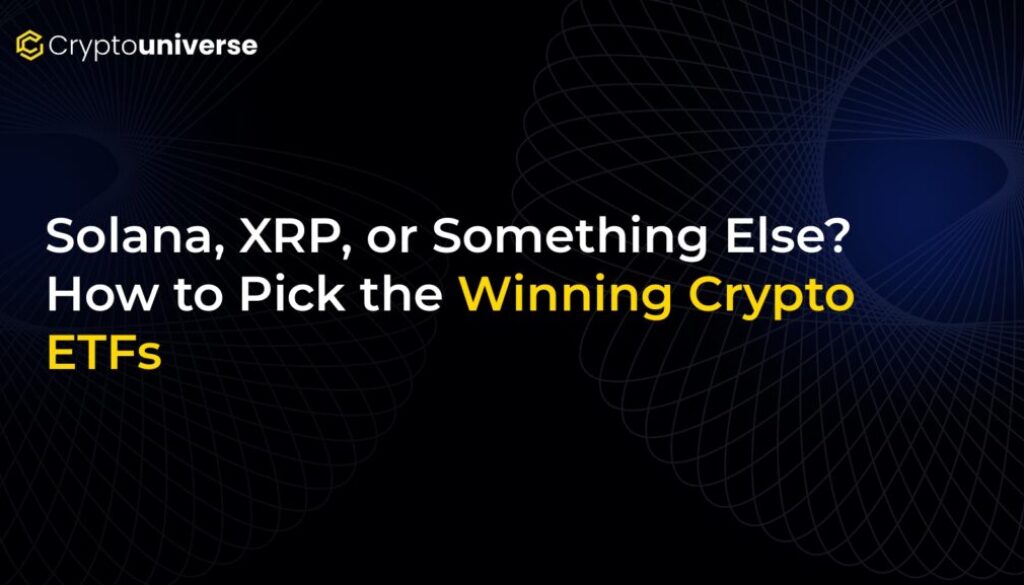Solana, XRP, or Something Else? How to Pick the Winning Crypto ETFs

The Bitcoin ETF Boom Was Just the Beginning
The launch of spot Bitcoin (BTC) ETFs in early 2024 wasn’t just a big moment for crypto; it was one of the most successful ETF launches in Wall Street history. Billions of dollars flooded into these new products, giving mainstream investors their first easy, regulated way to get direct exposure to Bitcoin. The floodgates opened, and the market responded with a powerful rally.
Now, the industry is buzzing with a simple question: What’s next? With the U.S. Securities and Exchange Commission (SEC) seemingly warming up to digital assets, experts predict a tidal wave of new crypto ETFs—potentially over 100 in the next year. But with a sea of new options on the horizon, how can you tell which new cryptocurrency ETFs are actually worth buying?
Navigating this new landscape requires a clear strategy. Let’s break down how to separate the promising contenders from the speculative duds.
Follow the Institutional Money: The First Rule of Crypto ETFs
While thousands of cryptocurrencies exist, only a select few have captured the serious attention of institutional investors. These are the large funds, asset managers, and corporations whose buying power can truly move markets. When they invest, they’re not chasing hype; they’re looking for assets with established technology, significant market capitalization, and long-term potential.
Data on institutional fund flows paints a clear picture of the crypto hierarchy:
- Bitcoin (BTC): The undisputed king, attracting tens of billions in institutional capital.
- Ethereum (ETH): The leader in smart contracts and decentralized finance, firmly in second place.
- Solana (SOL) & XRP (XRP): These two have emerged as the next tier, each attracting over a billion dollars in institutional interest.
Beyond these four, interest drops off dramatically. This tells us that the most viable and likely candidates for successful spot ETFs are Solana and XRP. In fact, analysts at JPMorgan have estimated that a spot Solana ETF could attract up to $6 billion in inflows, while a spot XRP ETF could see as much as $8 billion. This kind of sustained buying pressure from major players is what can drive an asset’s price upward over the long term.
Not All ETFs Are Created Equal: The Crucial Difference Between ‘Spot’ and ‘Exposure’
As new products launch, you’ll see a lot of confusing marketing language. This is the single most important distinction for investors to understand. A true spot ETF is simple and transparent: it buys and holds the actual cryptocurrency. When you invest $100 into a spot Bitcoin ETF, the fund manager uses that money to buy $100 worth of real Bitcoin.
However, many funds will offer “exposure” to a cryptocurrency without actually holding it. These products are often more complex and less direct. For example, the Rex-Osprey XRP ETF (XRPR) states it offers exposure to spot XRP, but its prospectus reveals a key detail: it only invests “at least 80%” of its assets in XRP and other assets that provide exposure to it.
What does this mean for you?
- Lack of Purity: You’re not getting 100% pure exposure. The fund can hold derivatives, futures contracts, or other related assets, which may not track the price of the underlying crypto perfectly.
- Complexity Risk: These synthetic structures can introduce counterparty risks and other complexities that don’t exist with a simple spot ETF.
- Diluted Impact: The massive price impact of the Bitcoin ETFs came from the funds directly buying BTC on the open market. Synthetic ETFs don’t create the same direct buying pressure.
The bottom line: When evaluating a new crypto ETF, demand transparency. Insist on a true spot product that is 100% backed by the physical cryptocurrency.
Three ETF Red Flags to Avoid at All Costs
As Wall Street gets creative, a number of flashy but dangerous products will likely appear. Here are three types of crypto ETFs you should approach with extreme caution.
1. The Leverage Lure
Some ETFs will offer 2x or even 3x leveraged exposure to cryptocurrencies. While the potential for amplified gains is tempting, these are designed for short-term traders, not long-term investors. The inherent volatility of crypto, combined with leverage, is a recipe for catastrophic losses. The complex fee structures and daily rebalancing of these funds also make them unsuitable for a buy-and-hold strategy.
2. The Meme Coin Mirage
It’s almost inevitable that we’ll see proposals for Dogecoin (DOGE) or Shiba Inu (SHIB) ETFs. Don’t fall for it. Meme coins are fundamentally speculative assets driven by social media hype rather than technological utility or institutional adoption. Wrapping a highly speculative asset in an ETF wrapper doesn’t change its nature—it only makes it easier for unsuspecting investors to lose money. A meme coin ETF is still a bet on a meme.
3. The ‘Bells and Whistles’ Trap
Be wary of any ETF that seems overly complicated or boasts a “unique” strategy. These often come with significantly higher management fees that eat into your returns over time. The beauty of the spot Bitcoin ETFs was their simplicity. Stick to products that are easy to understand and have competitive fees.
The Verdict: Which Crypto ETFs Should Be on Your Radar?
The arrival of new crypto ETFs is an exciting development for investors, but it’s not a free-for-all. The prudent approach is to focus on quality over quantity.
Based on institutional demand, regulatory likelihood, and market maturity, the most promising future ETFs will be those for Solana (SOL) and XRP (XRP). When (and if) true spot versions of these ETFs are approved and launched, they will represent a significant milestone and a potentially valuable addition to a diversified crypto portfolio.
For everything else, exercise patience and skepticism. Let the market mature, and always prioritize simple, transparent, and low-cost spot ETFs backed by real assets with proven institutional backing. Your future portfolio will thank you.


